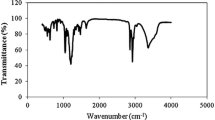Abstract
As high polar components of crude oil, asphaltenes play a significant role in reducing oil-water interfacial tension(IFT). In this paper, the effects of asphaltenes on reducing IFT in the presence of surfactant were compared, and the mechanism of asphaltenes reducing the IFT was studied by the dynamic interfacial tension(DIFT) equation. Whether asphaltenes were added to the oil or 2,5-dimethyl-4-(4-dodecyl) benzene sodium sulfonate(p-S14-4) was added to the water phase, either of all results in the IFT reducing and the IFT is related to the coverage and the mass of asphaltenes adsorption at the interface. In the presence of asphaltenes, the adsorption of the active substances to the interface is not entirely dependent on diffusion, and the process can be divided into three regions. Region I: the IFT rapidly reducing, this process is controlled by diffusion of surfactant; Region II: the IFT reducing slowly, resulted from the lower diffusion rate that is limited due to the aggregates formed by the interaction of asphaltene-asphaltene; Region III: the interaction of asphaltene-asphaltene is broken by the interaction of surfactant-asphaltene. The asphaltene aggregates are reduced and adsorbed rapidly at the interface. Furthermore, the results reveal that the asphaltenes concentration affects the coverage rate and adsorption at the interface.
Similar content being viewed by others
References
Zhang F. T., Fundamentals of Molecular Interface Chemistry, Shanghai Scientific and Technological Literature Press, Shanghai, 2006
Kiani S., Jones D. R., Alexander S., Barron A. R., J. Colloid Interf. Sci., 2020, 571(1), 307
Liang W. J., Heavy Oil Chemistry, University of Petroleum Press, Qingdao, 2000
Horvath-Szabo G., Masliyah J. H., Elliott J. A. W., Yarranton H. W., Czarnecki J., J. Colloid Interf. Sci., 2005, 283(1), 5
Sheu E., Energ. Fuel., 2002, 16(1), 74
Groenzin H., Mullins O. C., J. Phys. Chem. A, 1999, 103(50), 11237
Rane J. P., Harbottle D., Pauchard V., Couzis A., Banerjee S., Langmuir, 2012, 28(26), 9986
Eyssautier J., Levitz P., Espinat D., Jestin J., Gummel J., Grillo I., Barrie L., J. Phys. Chem. B, 2011, 115(21), 6827
Kuznicki T., Masliyah J. H., Bhattacharjee S., Energ. Fuel., 2009, 23(10), 5027
Santos D., Souza W., Santana C., Lourenço E., Santos A., Nele M., ACS Omega., 2018, 3(4), 3851
Zhang S., Zhang L., Lu X., Shi C., Tang T., Wang X., Huang Q., Zeng H., Fuel, 2018, 212(15), 387
Mohammadi M., Zirrahi M., Hassanzadeh H., Energ. Fuel., 2020, 34(3), 3144
Jian C. Y., Poopari M. R., Liu Q. X., Zerpa N., Zeng H. B., Tang T., J. Phys. Chem. B, 2016, 120(25), 5646
Mohammadi M., Zirrahi M., Hassanzadeh H., J. Phys. Chem. B., 2020, 124(15), 3206
Campen S. M., Moorhouse S. J., Wong J. S. S., Langmuir, 2019, 35(37), 11995
Wang X., Chemical Engineering & Equipment, 2019, 5, 84
Yang M. Q., Development of Alkalescent ASP Flooding Surfactant and Study on the Dynamic Action Mechanism of Alkali, Jilin University, Changchun, 2018, 20
Fainerman V. B., Lucassen-Reynders E. H., Adv. Colloid Interfac., 2002, 96(25), 295
Rosen M. J., Kunjappu J. T., Surfactants and interfacial phenomena (4th Edition), Chemical Industrial Press, Beijing, 2015
Wang S., Liu J., Zhang L., Xu Z., Masliyah J., Energ. Fuel., 2009, 23(2), 862
Langevin D., Argillier J. F., Adv. Colloid Interfac., 2016, 233, 83
Zarkar S., Pauchard V., Farooq U., Couzis A., Banerjee S., Langmuir, 2015, 31(17), 4878
Author information
Authors and Affiliations
Corresponding author
Ethics declarations
The authors declare no conflicts of interest.
Supporting Information
Rights and permissions
About this article
Cite this article
Wang, Y., Cheng, T. & Zhou, G. Study on the Mechanism of Asphaltenes Reducing Oil-Water Interfacial Tension. Chem. Res. Chin. Univ. 38, 616–621 (2022). https://doi.org/10.1007/s40242-021-1178-3
Received:
Accepted:
Published:
Issue Date:
DOI: https://doi.org/10.1007/s40242-021-1178-3




